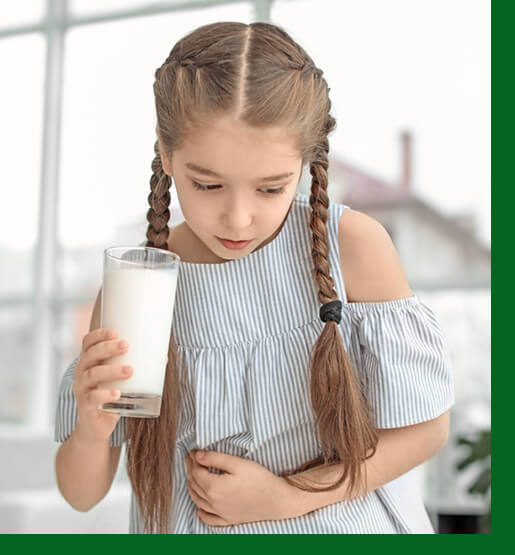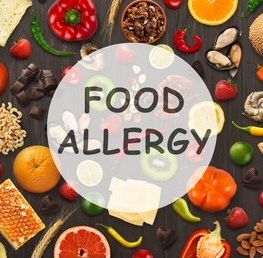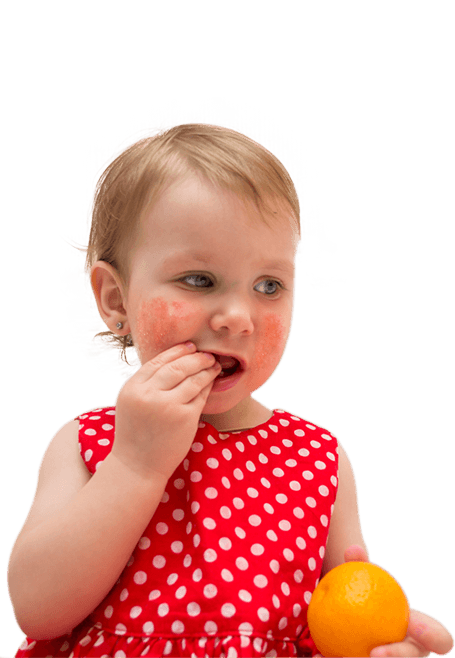
Food allergy
What is Food Allergy?
Food allergy is an adverse immune system reaction that occurs within minutes to hours after ingesting certain specific foods.
When the food-specific Ig antibodies of the body encounter the food protein and bind to that, they trigger the discharge of histamine and many different inflammatory molecules & chemicals that cause symptoms of an allergic reaction.


Do I have food allergy ?
Food allergy can be considered if allergic symptoms occur within minutes to hours after ingestion of a specific food, particularly when symptoms occur on one or more occasions.
The symptoms usually are :
abdominal symptoms like bloating,
nasal allergic symptoms like sneezing
and watering.
skin rashes/eczema
Swelling (angioedema) of the eyes, lips,
tongue
itching of mouth/lips/tongue/throat
wheezing/breathlessness
Even a little quantity of the allergy-causing foods will trigger signs and symptoms.
Rarely an allergy will cause severe symptoms or maybe even a grievous, potentially life-threatening reaction called ANAPHYLAXIS reaction.
Some patients have what is called Food-Pollen Allergy Syndrome. In this condition, individuals with strong reactions to certain pollens will experience cross-reactivity with certain fruits and vegetables. These allergic reactions may not show up on typical allergy testing. An allergist will help determine which of these fruits and vegetables are causing your reactions.

Which foods are commonly allergenic?
The top eight food allergens causing the majority (80%) of food allergies. are:
 Eggs
Eggs Peanuts
Peanuts Soy
Soy Wheat
Wheat  Milk
Milk  Fish
Fish  Shellfish
Shellfish  Tree nuts
Tree nuts
How is food allergy diagnosed?
Medical history is is essential to guide the diagnosis of food allergy. It is very important for physicians to take a good case history in the context of knowledge about food allergy and then judiciously select tests to confirm suspected allergies.
A skin prick test (SPT) will confirm your reaction to a particular food. During this test, a small quantity of the suspected food is placed on the skin of your forearm or back. A doctor or caregiver then pricks your skin with a needle to permit a small quantity of the substance to enter under your skin. If you are allergic to a specific substance being tested, you would develop a raised bump and a flare (reddened skin) reaction. However, even though a positive reaction to the SPT may raise the possibility of the corresponding food allergy, SPT alone is not enough to verify a food allergy.
A blood test: A blood test can measure your immune system's response to specific foods by measuring the specific allergy-related protein called serum immune globulin (sIgE).
Component testing is the most precise diagnostic tool for food allergies. It measures the specific IgE to component proteins of the foods and can precisely diagnose the allergic reaction to major and minor allergenic proteins. It is currently available in India.
Elimination diet: you will be asked to eliminate a few suspected foods for every week or 2 and then add the foods back to your diet one at a time. This method will facilitate the patient to link symptoms to specific foods. However, an elimination diet cannot tell you whether or not your reaction to a food could be a true allergic reaction rather than a food sensitivity. Also, if you have had a severe reaction to a food within the past, an elimination diet might not be safe.
Oral food challenge. This is the GOLD STANDARD for the confirmatory diagnosis of food allergies; During this test which is performed in the Clinic, you will be given tiny but gradually increasing amounts of the food suspected of causing your symptoms. If you do not have a reaction throughout this test, you will be able to include this food in your diet once more. A Food Challenge Test is only needed when the patient's history and test results are ambiguous.
Food Intolerance
Food allergy is often confused with a common reaction called food intolerance. This is generally a less serious condition that doesn't involve the immune system. A food intolerance or a reaction to a different substance you ate could cause identical signs and symptoms as an allergy, therefore certain tests are also required to diagnose the condition. Depending upon the kind of food intolerance you've got, you will be able to eat tiny amounts of the suspected foods without developing a reaction. Against this, if you've got a real allergy, even a little quantity of food could trigger an allergic reaction.
Common conditions which will cause symptoms mistaken for a food allergy include :
Absence of an enzyme protein required to totally digest a food. you may not have adequate amounts of some enzymes required to digest particular foods, e.g. Reduced quantities of Lactase may cause Lactose intolerance, which is due to a genetic disorder, and will cause bloating, cramping, looseness of the bowels and excess gas.
Sometimes bacterial infection in certain spoilt foods can mimic food allergy. Bacterium in spoiled foods can also create a poisonous substance that triggers harmful reactions.
Sensitivity to food additives. Some individuals have biological reactions causing different symptoms when ingesting certain food additives; for example, sulfites which are used to preserve dried fruit, canned food products and wine will trigger respiratory illness attacks in sensitive individuals.
Histamine toxicity. Certain fish, like tuna that are not preserved properly, may contain high amounts of bacterium & can also contain high levels of histamine that trigger symptoms just like those of allergy. While celiac disease is sometimes referred to as a gluten allergy, it does not result in anaphylaxis.
Like a food allergy, it does involve an immune system response, but it's a unique reaction different from a simple food allergy. This chronic digestive condition is triggered by eating gluten, a protein found in bread, pasta, cookies, and many other foods containing wheat, barley or rye.
Prevention: The best way to prevent a reaction is to know and avoid foods that cause signs and symptoms.
It may sometimes be difficult because these foods, when used as ingredients in certain dishes, may not be immediately noticed. This is especially true in restaurants and parties.
Paediatricians should also be aware that not all food allergies evolve from the production of IgE antibodies, and these will be missed on IgE antibody-based tests. Examples of non-IgE-mediated allergies include food-protein-induced enterocolitis (FPIES), symptoms of which start 2 hours after ingesting the offending food allergen, and allergic colitis, characterized by mucous-containing bloody stools.
How do I prevent food allergies?
Avoidance is the GOLD STANDARD. However, despite your best efforts, you may come into contact with a food that causes a reaction. For a minor allergic reaction, over-the-counter antihistamines may help reduce symptoms. These drugs can be taken after exposure to an allergy-causing food to help relieve itching or hives.
However, antihistamines can't treat a severe allergic reaction. For a severe allergic reaction (anaphylaxis), you may need an emergency injection of epinephrine and a trip to the emergency room. This device is a combined syringe and needle that injects a single dose of epinephrine when pressed against the thigh. If the doctor has prescribed an epinephrine autoinjector, carry it with you always. • Be sure you know how to use the autoinjector. Also, make sure the people closest to you know how to administer the drug — during an anaphylactic emergency, they could save your life.
How is food allergy treated ?
Oral immunotherapy. Researchers have been studying the use of oral immunotherapy as a treatment for food allergy. A food allergy patient taking oral immunotherapy (OIT) eats increasing, but carefully measured doses of their allergy-provoking food in an attempt to become desensitized to the problem food. Initial results appear promising, even in people with peanut, egg and milk allergies. In expert hands this treatment is safe. • A typical course of OIT begins with a tiny initial dose of the allergen, followed by escalating doses under medical supervision, starting with tiny amounts of food protein and doubling repeatedly to a small, tolerated dose. Next, over 4 to 6 months, this daily dose is increased each week or two under supervision until a maintenance dose is reached. The maintenance dose is consumed every day for many months. Typical OIT doses are measured in milligrams or grams. • Oral food challenges during the maintenance period test how much food allergen the patient can eat without reaction following treatment. A desensitized patient can tolerate an oral food challenge while their program of daily maintenance dosing continues.
In sublingual (“beneath the tongue”) immunotherapy,or SLIT, food allergen is dissolved in a small amount of liquid and held under the tongue for several minutes before being swallowed. This introduces undigested allergen to cells in the lining of the mouth that promote food tolerance. SLIT has been used to treat peanut, hazelnut, milk and peach allergies. SLIT doses are typically measured in micrograms or milligrams. • Compared to OIT, more and more studies have investigated SLIT, and SLIT has shown promise as a validated treatment modality. Successful desensitization using either approach raises a patient’s reaction threshold, increasing the amount of problem food they can tolerate. On average, the amount of allergen tolerated after desensitization is greater with OIT, but SLIT is safer, with fewer systemic reactions and milder reaction symptoms. HOWEVER, A GREATER NUMBER OF PATIENTS ARE ABLE TO CONSUME THE ALLERGIC FOODS NORMALLY AFTER OIT.
OIT has allowed many patients to lead a normal life and ingest the allergenic foods without the risk of anaphylaxis and represents a new paradigm in the management of food allergies.
Early exposure. In the past, it's been generally recommended that children avoid allergenic foods to reduce the likelihood of developing allergies. But in a recent study, high-risk children who regularly consumed peanut protein, such as peanut butter or peanut-flavored snacks, were 70 to 86 percent less likely to develop a peanut allergy. These findings may impact food allergy guidelines in the future.
Anti-IgE therapy. The medication omalizumab (Xolair) interferes with the body's ability to use IgE. The drug is currently being studied for treatment of allergic asthma and food allergies.
Allergy World clinics offer under-the-tongue allergy drops (SLIT) or Oral immunotherapy that contain extracts of more than 50 different food items. Contact an Allergy World Clinic near you for further information.
For the 1st time in India, ALLERGY WORLD OFFERS WORLD-CLASS CLINICALLY VALIDATED SOLUTIONS FOR THE PRECISE COMPONENT-RESOLVED DIAGNOSIS TO PIN-POINT THE EXACT PROTEIN CAUSING ALLERGY V/S SENSITISATION AS WELL AS ORAL IMMUNOTHERAPY FOR DEFINITIVE TREATMENT

If You Think You Have Allergy
mail us your info.
